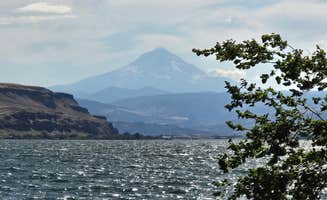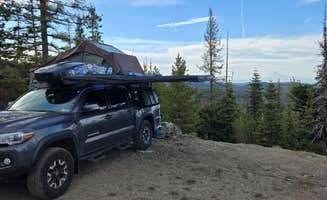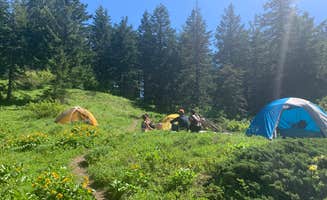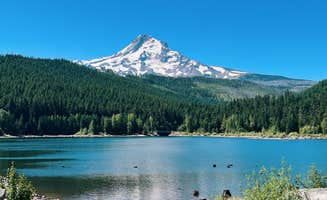Primitive camping near Goldendale, Washington offers options across varied elevations ranging from riverside sites at 200 feet to mountain locations above 4,000 feet. The Klickitat River watershed provides numerous unnamed pull-offs with existing fire rings along forest service roads. Most sites remain accessible from April through October, with high elevation locations experiencing snow closure in winter months.
What to do
Waterfall hiking: Camp at Dispersed Camping above Panther Creek Falls for direct access to one of the region's most impressive waterfalls. "You can hear the noise of the waterfall from up on the ridge," notes Sarah S., who camped at the site. The main camping area sits atop a large rock outcrop with falls viewable below.
Stargazing: The open plateau at Top 'O the Mountain provides exceptional night sky viewing when clouds clear. "At the top of a mountain with gorgeous views of Mt. Hood and all the other mountains and valleys below," writes Erik I. about this primitive site. Minimal light pollution makes summer meteor showers particularly visible.
Fishing access: Many riverside sites provide direct water access. One camper at Three Mile Canyon Park reports: "We were able to back in and view the Columbia river from our dinette window." The area contains several established fishing spots along calm sections of the river with beach access for small watercraft launching.
What campers like
River proximity: Sites at Avery Rec Area place campers directly on Columbia River waterfront. "Over half the 'sites' are right on the water, while the others are less than 50 feet away," explains Evan W. The area includes a small swimming spot steps from some sites.
Mountain views: Multiple dispersed areas provide clear views of regional peaks. "You can see Mt Hood from the campsite through the trees, albeit it is decently far away and is subject to the visibility at the time you visit," notes Brendan R. about Forest Rd 2730. Morning hours typically offer clearest visibility before afternoon haze.
Private campsites: Several locations offer separated camping spots with natural barriers. "There was actually someone else back there, and we can't hear nor see each other," reports Jason B. about Forest Rd 2730. Many sites include existing fire rings and established parking areas off main roads.
What you should know
Train noise: Multiple reviews mention significant train disruption at riverside locations. "You don't just have trains passing, you have them blowing their horn multiple times a night, and they are close enough you can feel their vibration," warns Tavi C. about Avery Rec Area. Campers report trains passing approximately every 30-45 minutes.
Water availability: No potable water exists at any dispersed sites. A camper at Big Huckleberry Mountain identifies limited natural sources: "The first water source is a PVC pipe that trickles water out... The other is a stream that you'll have to stick your filter bag into."
Site conditions: Many areas consist of basic gravel pull-offs. "It is just a big gravel parking lot, so don't expect any privacy," notes one Avery Rec Area camper. Most sites lack defined boundaries, requiring respectful spacing between camping groups.
Tips for camping with families
Choose riverside sites: Columbia River locations provide natural play areas for children. "Great little swimming spot steps from our spot," shares Ann W. about their Avery Rec Area experience. Sites near water typically include flat areas suitable for multiple tents.
Prepare for weather extremes: Temperature fluctuations can be significant, especially at higher elevations. "Got a little chilly at night with winds whipping down through the area we were in," notes Brendan R. about Forest Rd 2730. Pack layers even for summer camping.
Consider toilet access: Most dispersed areas lack facilities. Morrison Creek offers one of few primitive sites with toilets. "Nice flat tent sites, good fire rings, and picnic table. 2 pit toilets and a trailhead," reports Kate N. Several other sites require packing waste out completely.
Tips from RVers
Size limitations: Most dispersed sites accommodate smaller rigs only. "I parked nearest the access road, as my van would have hit trees to go a little further in," explains Jason B. about Forest Rd 2730. High-clearance vehicles access more remote sites with wider turning radius.
Leveling challenges: Bring leveling blocks as most sites sit on uneven terrain. "There are several places along FR 2730 where you can pull off and camp. The road was very accessible, high clearance not required," notes Brendan R., though he adds that group sites may require AWD for access.
Limited turnaround space: Several areas require backing into sites with minimal space for adjustments. Multiple reviewers mention larger RVs struggling with site access, with many needing to park at main trailhead lots rather than accessing more secluded spots.






